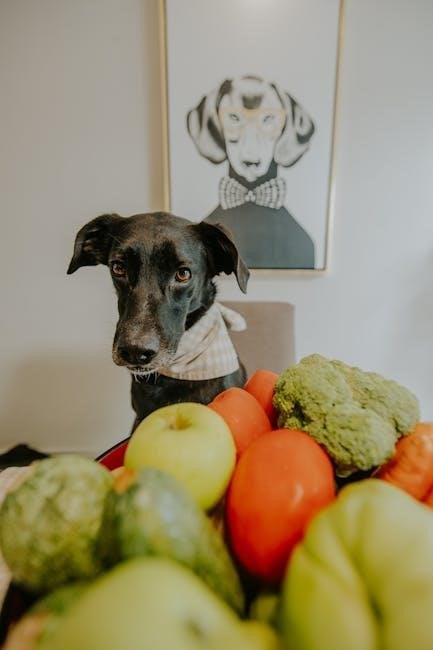toxic food for dogs pdf

Toxic Foods for Dogs: An Overview
Many seemingly harmless human foods pose significant risks to canine health. Increased awareness‚ fueled by online resources‚ highlights potential dangers. This overview explores common toxic foods‚ empowering dog owners to prevent accidental poisonings and ensure their pet’s safety.
Increased Awareness of Toxic Foods
The digital age has ushered in an era of heightened awareness regarding the dangers of certain human foods for dogs. Social media platforms‚ pet-centric websites‚ and online veterinary resources have collectively contributed to disseminating crucial information to dog owners worldwide. This increased accessibility to knowledge empowers pet parents to proactively safeguard their furry companions from potential harm.
Consequently‚ there’s a growing understanding that many common household items and seemingly innocuous foods can be exceptionally toxic to dogs. This awareness extends beyond just chocolate‚ encompassing a broader range of substances like onions‚ garlic‚ grapes‚ raisins‚ macadamia nuts‚ and even artificial sweeteners like xylitol. The result is a more cautious approach to feeding dogs human food.
Furthermore‚ veterinary clinics are also leveraging online platforms to educate pet owners on food-related dangers. By sharing lists of toxic foods and outlining potential symptoms of poisoning‚ veterinary professionals are actively engaging in preventative care. This proactive approach‚ coupled with readily available online information‚ fosters a community of informed and responsible dog owners.

Common Toxic Foods for Dogs
Several everyday foods pose a threat to canine health. This section details common culprits‚ including chocolate‚ onions‚ grapes‚ and xylitol. Understanding these risks is crucial for responsible pet ownership and preventing accidental poisonings.
Chocolate and Methylxanthines
Chocolate’s danger to dogs stems from methylxanthines‚ stimulants toxic to their systems. Different chocolate types vary in methylxanthine levels‚ with dark chocolate and baking chocolate posing the greatest threat. These substances affect the nervous system and heart‚ leading to vomiting‚ diarrhea‚ increased heart rate‚ and hyperactivity. In severe cases‚ chocolate ingestion can cause seizures‚ tremors‚ and even death. The lethal dose of caffeine‚ a methylxanthine‚ is 150mg/kg. Prompt veterinary attention is crucial if a dog consumes chocolate. Even small amounts can be harmful‚ especially to smaller breeds. Always keep chocolate out of reach to prevent accidental ingestion and safeguard your dog’s well-being. The severity depends on the type and amount of chocolate consumed.
Onions and Garlic: The Thiosulphate Threat
Onions and garlic‚ common ingredients in human food‚ pose a significant threat to dogs due to the presence of thiosulphate. This compound damages red blood cells‚ leading to anemia. Onions are generally more toxic than garlic‚ but both should be avoided. Thiosulphate accumulates in the dog’s system‚ meaning even small‚ repeated exposures can lead to toxicity over time. While some dog biscuits contain small amounts of garlic‚ larger quantities are dangerous. Symptoms of thiosulphate poisoning include weakness‚ lethargy‚ pale gums‚ and vomiting. Immediate veterinary care is essential if you suspect your dog has ingested onions or garlic. Prevention is key‚ so keep these foods out of reach and avoid feeding your dog table scraps that may contain them. Cooking does not eliminate the toxicity of onions and garlic.
Grapes and Raisins: Risk of Kidney Failure
Grapes and raisins‚ seemingly harmless fruits‚ present a serious risk of kidney failure in dogs. The exact toxic substance within these fruits remains unidentified‚ making it difficult to determine a safe dosage. Even small amounts can be harmful‚ and the severity of the reaction varies between individual dogs. Some dogs may experience only mild gastrointestinal upset‚ while others develop acute kidney failure‚ which can be fatal. Symptoms of grape or raisin toxicity include vomiting‚ diarrhea‚ lethargy‚ decreased appetite‚ and increased thirst and urination‚ followed by a decrease in urination as kidney function declines. Due to the potential for severe kidney damage‚ it is crucial to prevent your dog from consuming grapes or raisins in any form. Immediate veterinary attention is necessary if your dog ingests these fruits.
Macadamia Nuts: Weakness and Tremors
Macadamia nuts‚ while a popular snack for humans‚ are considered toxic to dogs and can cause a range of unpleasant symptoms. While the exact mechanism of toxicity is not fully understood‚ ingestion of macadamia nuts can lead to weakness‚ tremors‚ hyperthermia (increased body temperature)‚ vomiting‚ and depression in dogs. The severity of these symptoms can vary depending on the amount consumed and the size of the dog. Typically‚ symptoms appear within a few hours of ingestion and can last for up to 48 hours; Although macadamia nut toxicity is rarely fatal‚ it can be a distressing experience for both the dog and owner. It is important to keep macadamia nuts out of reach of your dog to prevent accidental ingestion. If your dog does consume macadamia nuts‚ it’s advisable to contact your veterinarian for guidance and monitoring. Supportive care‚ such as fluids and anti-emetics‚ may be necessary to alleviate symptoms and ensure a full recovery.
Xylitol: The Artificial Sweetener Danger
Xylitol‚ a sugar alcohol commonly used as an artificial sweetener in sugar-free gums‚ candies‚ baked goods‚ and even some peanut butters‚ poses a significant threat to dogs. Even small amounts of xylitol can be highly toxic. When ingested by dogs‚ xylitol causes a rapid release of insulin from the pancreas‚ leading to a precipitous drop in blood sugar levels (hypoglycemia). This can occur within 10 to 60 minutes of ingestion. Symptoms of xylitol toxicity include weakness‚ staggering‚ seizures‚ and collapse. In severe cases‚ xylitol can also cause liver failure. Due to the rapid onset of symptoms and the potential for life-threatening complications‚ it is crucial to seek immediate veterinary care if you suspect your dog has ingested xylitol. Treatment typically involves intravenous glucose administration to stabilize blood sugar levels‚ as well as monitoring of liver function. Prevention is key; always check labels carefully and keep products containing xylitol out of reach of your canine companion.

Other Potentially Harmful Foods
Beyond the common culprits‚ several other foods can be detrimental to dogs. While not always fatal‚ these items can cause gastrointestinal upset‚ and other adverse reactions. Moderation and careful consideration are essential.
Mushrooms: A Deadly Threat
Mushrooms present a significant danger to dogs due to the varying toxicity levels among different species. Some mushrooms contain potent toxins that can cause severe organ damage‚ neurological issues‚ and even death. Identifying edible from poisonous mushrooms is challenging‚ making it crucial to prevent dogs from consuming any wild mushrooms.
The severity of mushroom poisoning depends on the species ingested and the amount consumed. Symptoms can range from vomiting and diarrhea to seizures and liver failure. Immediate veterinary attention is essential if you suspect your dog has eaten a mushroom.
Owners should inspect their yards regularly and remove any mushrooms to minimize the risk. When walking dogs in wooded areas‚ keep them on a leash to prevent them from foraging for mushrooms. Remember‚ even seemingly harmless mushrooms can pose a deadly threat to your beloved companion.
Alcohol: Avoid All Alcoholic Beverages
Alcohol is highly toxic to dogs‚ even in small amounts. Its consumption can lead to severe health problems‚ including central nervous system depression‚ incoordination‚ vomiting‚ diarrhea‚ and even death. Dogs metabolize alcohol much slower than humans‚ making them more susceptible to its harmful effects.
Alcohol affects a dog’s brain and liver‚ disrupting normal function. The severity of the effects depends on the amount of alcohol consumed and the dog’s size. Smaller dogs are at a higher risk of severe poisoning.
It’s crucial to keep all alcoholic beverages out of reach of dogs. This includes not only drinks but also products containing alcohol‚ such as certain mouthwashes and cough syrups. Never intentionally give a dog alcohol‚ even as a joke. If you suspect your dog has ingested alcohol‚ seek immediate veterinary care. Prompt treatment can significantly improve the chances of recovery and minimize long-term damage. Remember‚ a responsible pet owner is a vigilant one‚ ensuring their furry friend’s well-being by avoiding all alcoholic beverages.
Household Items as Potential Dangers
Beyond food‚ many common household items pose a significant threat to dogs. A dog’s natural curiosity can lead them to ingest dangerous substances‚ resulting in serious health consequences. Medications‚ cleaning supplies‚ and certain plants are among the most common culprits.
Over-the-counter and prescription medications‚ even those safe for humans‚ can be toxic to dogs. Cleaning products like bleach‚ detergents‚ and disinfectants contain harsh chemicals that can cause severe burns and internal damage. Antifreeze‚ with its sweet taste‚ is particularly dangerous‚ as even a small amount can lead to kidney failure.
Certain houseplants‚ such as lilies and azaleas‚ are also poisonous to dogs. It’s crucial to identify and remove any potentially harmful plants from your home. Store all medications and cleaning supplies in secure cabinets‚ out of reach of your dog. Regularly inspect your home for potential hazards and take steps to eliminate them. By being proactive‚ you can create a safer environment for your canine companion.

Symptoms of Food Poisoning in Dogs
Recognizing the symptoms of food poisoning in dogs is crucial for prompt intervention. The signs can vary depending on the substance ingested‚ the amount consumed‚ and the dog’s individual sensitivity. However‚ some common indicators can alert you to a potential problem.
Gastrointestinal distress is often the first sign‚ manifesting as vomiting‚ diarrhea‚ and loss of appetite. The dog may also exhibit abdominal pain‚ indicated by restlessness‚ whining‚ or a hunched posture. Lethargy‚ weakness‚ and dehydration can quickly follow as the body attempts to eliminate the toxin.
In more severe cases‚ neurological symptoms such as tremors‚ seizures‚ and incoordination may develop. Difficulty breathing‚ excessive drooling‚ and changes in heart rate are also cause for concern. If you observe any of these signs‚ especially if you suspect your dog has ingested a toxic substance‚ seek immediate veterinary attention. Early diagnosis and treatment can significantly improve the chances of a full recovery.

What to Do If Your Dog Eats a Toxic Food
If you suspect your dog has ingested a toxic food‚ immediate action is paramount. First‚ remain calm to assess the situation effectively. Identify the suspected substance and estimate the amount consumed. This information will be crucial for your veterinarian.
Do not induce vomiting unless specifically instructed by a veterinarian or poison control expert. Some substances can cause more damage coming back up. Contact your veterinarian or the ASPCA Animal Poison Control Center immediately. Be prepared to provide details about your dog’s breed‚ weight‚ age‚ and any existing health conditions.
Follow their instructions carefully. They may advise bringing your dog to the clinic for examination and treatment. If instructed to induce vomiting at home‚ use hydrogen peroxide (3%) orally‚ but only under guidance. Collect a sample of the vomited material‚ as well as any packaging or remnants of the suspected toxin‚ for the veterinarian to analyze. Prompt action can significantly improve your dog’s prognosis.
Leave a Reply
You must be logged in to post a comment.